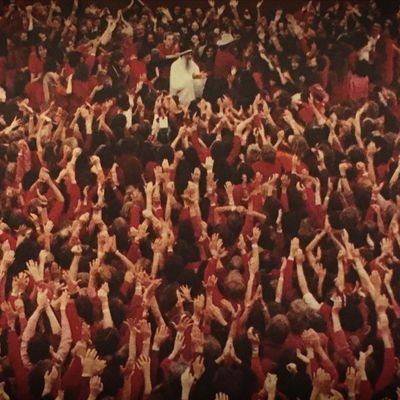
There are many shocking things about Wild Wild Country, Netflix’s documentary series about Bhagwan Shree Rajneesh (a.k.a. Osho), the spiritual leader who brought an army of his Rajneeshee followers to overrun the tiny town of Antelope, Oregon, in 1981. It’s a twisty story that goes to very shocking and unexpected places, so we’re going to try something a little different: Instead of typical recaps, we’ll highlight the most surprising discoveries unearthed by directors Chapman and MacLain Way after each installment of the six-part series.
Let’s get started, shall we? Here are the most intriguing and eye-opening details from Wild Wild Country, “Part 1”.
You can’t take your eyes off of Ma Anand Sheela
When we meet Bhagwan’s former personal secretary, she’s a chic, articulate, and attractive older woman living in a forest somewhere in Switzerland. We’re told she fled to West Germany in the ’80s in an attempt to avoid charges of fraud and attempted murder for some kind of poisoning. The poisoning itself is vaguely mentioned, and it’s not clear what led her to flee the United States in the first place. What could she have possibly done? What does it have to do with the Rajneeshees? And why is she Bhagwan’s “former” secretary?
The very first speech Sheela delivers in Wild Wild Country sets the tone for whatever did happen. “With every crown comes the guillotine. Without the guillotine you cannot wear the crown. And it was my fate,” she says. “But why does one have to put someone under the guillotine? Because of their strength. They want to destroy their strength. And in spite of guillotine, they haven’t killed me yet. They haven’t killed my spirit yet. No matter where I go, I will always wear a crown.” Yeah, I would let this woman cut me in line at the deli and I would still pay for her order.
Sheela previously had a normal American life
Sheela says she first met Bhagwan at the age of 16, and her devotion is clear from the beginning: “I saw Bhagwan and that was the end of me.” However, Bhagwan also agreed to let Sheela live in the U.S. and get a college degree. While there, she married Mark, a nice Jewish man who made her laugh. When we see a photo of Sheela lounging in bed with him and reading Vogue, she looks less like a member of a cult and more like, well, so many American women in their 20s.
Bhagwan’s very strange reaction to Sheela’s loss
Sheela’s husband Mark was a total hottie, but, sadly, he died of cancer soon after their marriage. In Wild Wild County, all these years later, Sheela still wells up with tears talking about their relationship and how he was the love of her life. After Mark’s death, she says, Bhagwan told the doctors to put her to sleep for three days. Three days! When she woke up, Bhagwan told her, “That chapter of your life is over. Now you can throw yourself into the work.” Yeah, that sounds like a cult.
Bhagwan’s meditation practice is … a lot
The Rajneeshee belief in “dynamic meditation” involves chaotic breathing followed by a round of emotional explosion where people can scream, shout, cry, and even beat up themselves or others. They also jump up and down and shout a primal “Hoo!” each time their feet touch the ground, like they’re seeing Daft Punk at Coachella. Then, everyone lies in silence somewhat like traditional meditation. The whole thing sounds, as the kids like to say, pretty extra.
Maroon? Seriously?
In the footage of Bhagwan’s followers at the Poona ashram, they’re dressed in yellows, oranges, saffrons, and similar colors. But when we see footage of his followers greeting Bhagwan in Oregon, they’re all wearing red or maroon. Now, I don’t think I could ever be a part of a group that forced you to wear maroon. I mean, maroon! No one looks good in maroon. Not even Naomi Campbell in the ’90s could pull of maroon. What on Earth would make you want to wear that dastardly color all the time? And aesthetic objections aside, why hasn’t anybody in this documentary explained why they’re all dressed alike?
The Rajneeshees wanted to be rich
During their interviews, Sheela and the other Rajneeshees say Bhagwan encouraged the accumulation of wealth and didn’t believe that one needed to be poor to be pure, unlike so many other of the world’s more established religions. The canny capitalists they were, the Rajneeshees even developed their own banking system: Based on the footage of life at the ashram, they way they did their banking looked like an old card catalogue in a library. How does this even work? Can you exchange those cards like currency? Is this like cultish bitcoin? Is this what blockchain is really all about?
What about the Antelope pies?
Directors Chapman and Maclain Way show archival footage of a community Christmas party in Antelope, which has a population of 40 people. On the counter during this party, we see roughly ten pies. First of all, those pies looked delicious and I want one. Second of all, how many pies could you possibly need for a town Christmas party when only 40 people are invited? Each person gets a whole quarter of a pie, and you know that Mary who works down at the post office doesn’t like sweets, so that means someone gets to eat an entire half of a pie. That is way too much pie!


